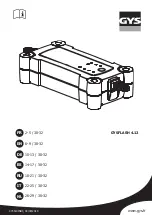
Page 7 of 8
Unit 2, 110 Station Road, Seven Hills ,NSW, 2147, Australia
1700W Solar Battery Charger
Maximum Power Point Tracker
Operating Instructions
Please read these instructions before use
Model:
MPPT30-2
Figure 5 (
Above
):
Vented Battery Setting
Figure 6 (
Above
):
Sealed Battery Setting
MPPT FAQs
Q: What is an MPPT?
MPPT stands for Maximum Power Point Tracker and is a specialized converter designed to maintain
the PV voltage at the level in which it delivers maximum power to the load or battery. The panel’s
nominal output power can only be obtained with the use of an MPPT.
Q: What are the GSL MPPTs advantages compared to standard solar regulators?
1. Suitable for new lower cost high efficiency grid type panels since the GSL MPPT can efficiently
charge the batteries from relatively high voltage, say 12V batteries from 36V MPP panels.
2. Less interference and more accurate voltages during absorption and float.
Q: What happens at low PV currents?
The MPPT will outperform the conventional regulator above 3% of nominal panel power. Below 3%,
about 10W in a 400W panel, the MPPT will have a slightly lower output current than a non MPPT.
MPPT30-2-R8
Q: Why are MPPT not more common in standalone solar systems?
Until now and despite their overwhelming advantages MPPTs have not been commonly used in
standalone solar systems because of cost. The new GSL MPPT specifically addresses this issue
making economic sense in a wide range of solar systems.


























